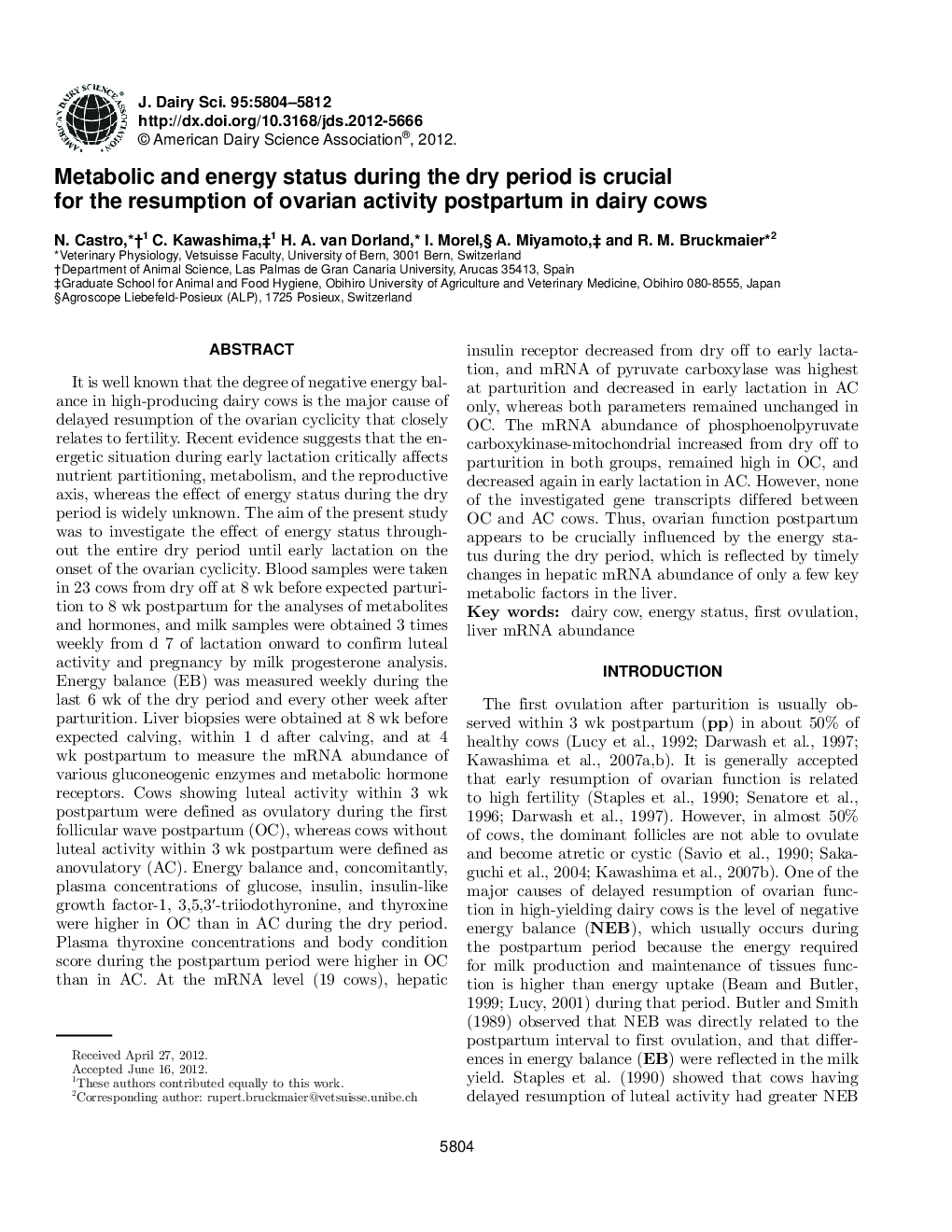| کد مقاله | کد نشریه | سال انتشار | مقاله انگلیسی | نسخه تمام متن |
|---|---|---|---|---|
| 10981233 | 1108075 | 2012 | 9 صفحه PDF | دانلود رایگان |
عنوان انگلیسی مقاله ISI
Metabolic and energy status during the dry period is crucial for the resumption of ovarian activity postpartum in dairy cows
دانلود مقاله + سفارش ترجمه
دانلود مقاله ISI انگلیسی
رایگان برای ایرانیان
موضوعات مرتبط
علوم زیستی و بیوفناوری
علوم کشاورزی و بیولوژیک
علوم دامی و جانورشناسی
پیش نمایش صفحه اول مقاله

چکیده انگلیسی
It is well known that the degree of negative energy balance in high-producing dairy cows is the major cause of delayed resumption of the ovarian cyclicity that closely relates to fertility. Recent evidence suggests that the energetic situation during early lactation critically affects nutrient partitioning, metabolism, and the reproductive axis, whereas the effect of energy status during the dry period is widely unknown. The aim of the present study was to investigate the effect of energy status throughout the entire dry period until early lactation on the onset of the ovarian cyclicity. Blood samples were taken in 23 cows from dry off at 8Â wk before expected parturition to 8Â wk postpartum for the analyses of metabolites and hormones, and milk samples were obtained 3 times weekly from d 7 of lactation onward to confirm luteal activity and pregnancy by milk progesterone analysis. Energy balance (EB) was measured weekly during the last 6Â wk of the dry period and every other week after parturition. Liver biopsies were obtained at 8Â wk before expected calving, within 1 d after calving, and at 4Â wk postpartum to measure the mRNA abundance of various gluconeogenic enzymes and metabolic hormone receptors. Cows showing luteal activity within 3Â wk postpartum were defined as ovulatory during the first follicular wave postpartum (OC), whereas cows without luteal activity within 3Â wk postpartum were defined as anovulatory (AC). Energy balance and, concomitantly, plasma concentrations of glucose, insulin, insulin-like growth factor-1, 3,5,3â²-triiodothyronine, and thyroxine were higher in OC than in AC during the dry period. Plasma thyroxine concentrations and body condition score during the postpartum period were higher in OC than in AC. At the mRNA level (19 cows), hepatic insulin receptor decreased from dry off to early lactation, and mRNA of pyruvate carboxylase was highest at parturition and decreased in early lactation in AC only, whereas both parameters remained unchanged in OC. The mRNA abundance of phosphoenolpyruvate carboxykinase-mitochondrial increased from dry off to parturition in both groups, remained high in OC, and decreased again in early lactation in AC. However, none of the investigated gene transcripts differed between OC and AC cows. Thus, ovarian function postpartum appears to be crucially influenced by the energy status during the dry period, which is reflected by timely changes in hepatic mRNA abundance of only a few key metabolic factors in the liver.
ناشر
Database: Elsevier - ScienceDirect (ساینس دایرکت)
Journal: Journal of Dairy Science - Volume 95, Issue 10, October 2012, Pages 5804-5812
Journal: Journal of Dairy Science - Volume 95, Issue 10, October 2012, Pages 5804-5812
نویسندگان
N. Castro, C. Kawashima, H.A. van Dorland, I. Morel, A. Miyamoto, R.M. Bruckmaier,